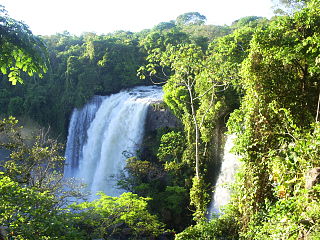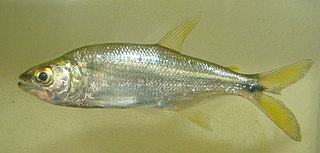
Characidae, the characids or characins, is a family of freshwater subtropical and tropical fish belonging to the order Characiformes. The name "characins" is an historical one, but scientists today tend to prefer "characids" to reflect their status as a, by and large, monophyletic group. To arrive there, this family has undergone much systematic and taxonomic change. Among those fishes remaining in the Characidae currently are the tetras, comprising the very similar genera Hemigrammus and Hyphessobrycon, as well as a few related forms, such as the cave and neon tetras. Fish of this family are important as food in several regions, and also constitute a large percentage of captive freshwater aquarium fish species.

Hyphessobrycon is a genus of freshwater fish in the family Characidae. These species are among the fishes known as tetras. The genus is distributed in the Neotropical realm from southern Mexico to Río de la Plata in Argentina. Many of these species are native to South America; about six species are from Central America and a single species, H. compressus is from southern Mexico.

Astyanax is a genus of freshwater fish in the family Characidae of the order Characiformes. Some of these fish, like many of their relatives, are kept as aquarium pets and known collectively as tetras. With around 150 described species and new ones being described yearly, this genus is among the largest of the entire order; Hyphessobrycon also has more than 145 species and which one is larger at any one time depends on whether more species have been recently described in one or the other. The blind and colorless cave tetra of Mexico is a famous member of the genus, but its taxonomic position is disputed: Some recognize it as part of the Mexican tetra and this is supported by phylogenetic evidence, but others recognize the cave form as a separate species, A. jordani.
Mimagoniates is a genus of characid fish from rivers and streams in southeastern, southern and central-western Brazil, northeastern Argentina, and Paraguay. The individual species generally have relatively small ranges and two, M. lateralis and M. sylvicola, are considered threatened by Brazil's Ministry of the Environment.

The Curuá River is a tributary of the Iriri River in Pará state in north-central Brazil. The river flows through the Tapajós-Xingu moist forests ecoregion. The river rises in the 342,192 hectares Nascentes da Serra do Cachimbo Biological Reserve, a strictly protected conservation unit established in 2005. It is one of the headwaters of the Xingu River.

Moenkhausia is a genus of freshwater fish in the family Characidae native to tropical and subtropical South America. These are medium-sized tetras where the largest species only reach around 12 cm (4.7 in).
Serra do Cachimbo is a low mountain range in the southern part of the state of Pará, Brazil. It is located mostly in the municipalities of Altamira, Itaituba, Jacareacanga, and Novo Progresso.

Bryconamericus is a genus of characins found in Central and South America.
Glandulocauda is a genus of small characin freshwater fish that are endemic to Brazil, where restricted to the upper Paraná basin and coastal river basins in São Paulo state. The genus it is closely related to Lophiobrycon and Mimagoniates, and they form the tribe Glandulocaudini.
Hysteronotus megalostomus is a species of characin endemic to Brazil where it is found in the upper São Francisco River basin. This species is the only member of the genus Hysteronotus.

Jupiaba is a genus of characins from South America. with 29 currently described species:
Knodus is a genus of characins, small freshwater fish from South America.
Lepidocharax is a genus of characins endemic to the Doce, Paraguaçu and São Francisco basins in eastern Brazil. They are small fish, that reach up to 4 cm (1.6 in) in standard length.
Nematocharax is a genus of freshwater fish in the family Characidae. It contains the single species Nematocharax venustus, which is endemic to Brazil, where it is found in the Jequitinhonha River basin. The males of this species can reach a length of 5.1 centimetres (2.0 in) SL while the females only grow to 3.5 centimetres (1.4 in) SL.

Oligosarcus is a genus of characins from freshwater habitats in northern Argentina, Paraguay, Uruguay, eastern Bolivia, and southern and central Brazil. They reach up to 31 cm (12 in) in length and are predators that mainly feed on smaller fish.
Rhinopetitia is a genus of characins endemic to Brazil.
Tyttobrycon is a genus of characins native to the Amazon Basin in South America.
Xenurobrycon is a genus of characins from tropical South America.

Erythrocharax altipinnis is a species of characid known only from Pará, Brazil, where it has been found in a small river. This species grows to 2.62 cm (1.03 in) in standard length. This species is the only known member of its genus.
Stanley Howard Weitzman was a Research Scientist Emeritus at Division of Fishes, National Museum of Natural History, Washington, D.C.








